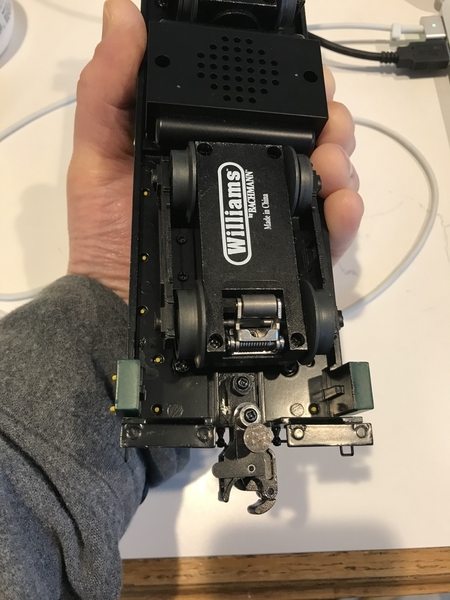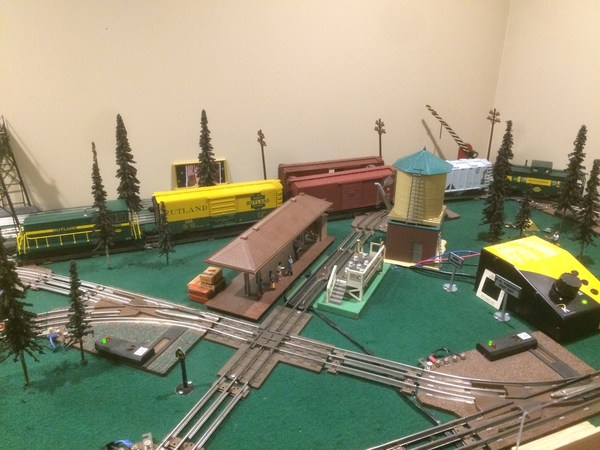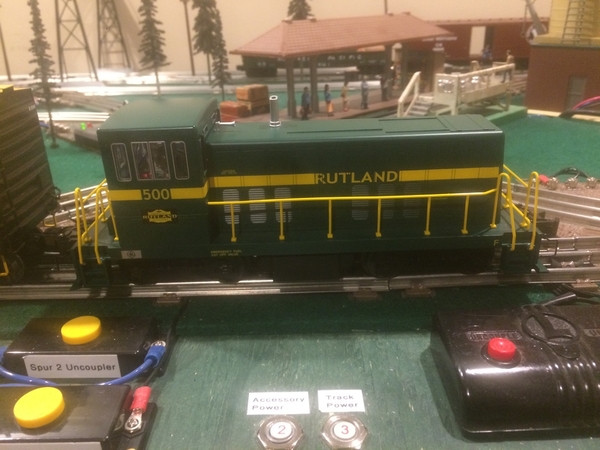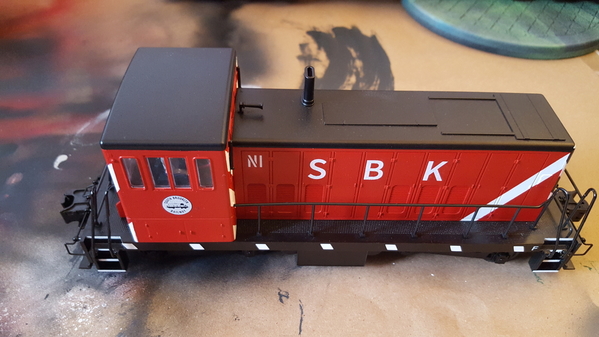. . . are finally in!
Either Charles Ro has yet to update their website or they've already sold them out, but they're shipping them. The 70-tonners are shown as in-stock on Bachmann's and other sites.
Replies sorted oldest to newest
My WBB Rutland GE 70-tonner finally arrived. First impressions:
- The detail is fantastic, compared to the Williams/WBB made from postwar molds. The paint scheme is lacking the yellow striping on the pilots and the front of the hood, but based on the early photos, that is not a surprise. Like the WBB scale 44-tonner, the handle rails are plastic. Handle with care. Otherwise, with it's diecast chassis gives it a nice heft for a small locomotive. The fixed pilots are nice.
- Like most if not all Williams/WBB locomotives, it's geared to far too high. Rewiring the motors from parallel to series was easy. (Use care when removing the shell to avoid breaking the plastic handrails.)
- The True Blast Plus sounds are nice, and the set volume is just about right, though the bell is a little hard to hear over the prime mover. (I forgot to look for a volume pot when I removed the shell to wire in-series.) It would be nice if the TBP had a battery or capacitor back-up to sustain the sounds of direction changes, maybe that's an upgrade for True Blast Plus II. :-)
- WBB rates it for O-27, however, when coupled to a consist, it failed to make the first curve without derailing the first car. Wheel slippage was audible. At first I thought that the fixed pilot was preventing the coupler from swinging far enough, however with upon inspection it turned out that it was the post on the coupler arm that engages the centering spring was preventing the coupler from traveling the full range of the hole in the pilot. It turns out that the groove in the chassis that this post travels in was the limiting factor. Solving the problem required a minor modification to the chassis—lengthening the groove. A Dremel tool would be ideal, a drill press would be nice, but careful work with a hand-held drill worked for me. A small piece of separately-applied detail, perhaps a handle of some type, that is on one side of the pilot opening had to be removed, too. These modifications were necessary to both the front and rear pilot.
- With series wiring and the pilot modifications made, it pulls my small Northeast consist nicely.
It would have been great if the modifications weren't necessary, but overall it seems to be a terrific conventional locomotive. I'm delighted to have it running on my layout at long last.
(I know, I need to take some close-ups.)
Attachments
Attachments
Attachments
Same problem with mine. Even on 0-36 radius track most cars will derail the front truck when coupled to the engine. Bachmann didn't test this much apparently. Disappointing.
I'll have to rewire the motors to slow it down. Otherwise it's a really nice model.
Attachments
I have not yet bought one, but when I do, it will be a repaint in cream, orange, and black. The Salzberg family owned a string of shortline railroads. This color scheme was used on the Wellsville, Addison & Galeton....and the 70 tonner was one of the first to get painted. It was, however never lettered for The WAG....it went to service the UV...Unadilla Valley Railroad.
Tom Shirey posted:I have not yet bought one, but when I do, it will be a repaint in cream, orange, and black. The Salzberg family owned a string of shortline railroads. This color scheme was used on the Wellsville, Addison & Galeton....and the 70 tonner was one of the first to get painted. It was, however never lettered for The WAG....it went to service the UV...Unadilla Valley Railroad.
Well, you are partially correct here. The Salzberg corporate colors were as you have stated. Many 70 tonners wore that paint scheme at other Salzberg shortlines. However, there was never a 70 tonner at the WAG. They did bring in a 50 ton center cab, battery electric. It did go to another of their lines in NY. In fact, in later years there were two of those battery electric locos stored at the "new" WAG engine house/shop. They both were cut up for scrap many years after the WAG shut down. The centercabs at the WAG all were over 100 ton, and all came from one of the Ford motor Company plants in Michigan.
Jeff
Matt GN027,
Thank you for sharing the video of your very nice layout. I'm curious about your track switches. It looks like you took Lionel 027 switches and substituted Ross switch machines on them. Is that what happened?
@tncentrr, even though I'm not Matt, I'm pretty sure those are the K-Line later production low profile 027 switches, which these days are becoming much harder to find. In part because they didn't have as long a production run time span. And in part because they are pretty popular with 027 guys: There are some train items that hit the switchbox housing on all the other types of 027 turnouts, but not on these.
Brianel,
I have always regretted that we lost k line. They really did do 027 right instead of treating it as a "second fiddle" to the larger trains. I have thought for a long time that 027 is under appreciated. There are things that can be done with 027 that could not be done with the larger trains. An interesting 027 layout could be done in less space, for example. I have quite a few 027 trains in my collection and would not even consider selling them.
tncentrr posted:Matt GN027,
Thank you for sharing the video of your very nice layout. I'm curious about your track switches. It looks like you took Lionel 027 switches and substituted Ross switch machines on them. Is that what happened?
@brianel_k-lineguy is spot on. They are the the last iteration of the K-Line O27 switches, K-0265 (LH) & K-0266 (RH). Other advantages over the Lionel O27 switches include:
- Instead of using a solenoid, they have a small motor. Once the switch is thrown, they don't continually fire like the solenoid-driven Lionel switches. (My understanding is that this is also true of the earlier K-265 & K-266 switches with incandescent bulbs, but I might be wrong about that.)
- They can be easily run off of either accessory power or track power. (The earlier K-265/266 switches shared this feature
- Unlike the earlier K-Line K-265/266 switches, they use LEDs instead of incandescent bulbs.
Bachmann can reproduce anything from K-LINE. You have to get to the management of Bachmann and tell them why these K-Line switches were great.
Andrew
Falconservice,
Maybe we could start one of those on-line petitions I keep hearing about. I have never signed one myself, and so, don't know much about them. I don't think it has ever been tried in our hobby.
Count me in if they can be convinced to build the switches again. The one thing I hate about my 027 layout is the buzzing 5121,22 switch solenoids.
I don’t think the customer should have to make these modifications. How could they not have seen this? I expect a locomotive to work out of the box without modifying anything, unless that’s your choice. So glad I read this, and thanks for posting. I’m not buying one.
IC fan posted:I don’t think the customer should have to make these modifications. How could they not have seen this? I expect a locomotive to work out of the box without modifying anything, unless that’s your choice. So glad I read this, and thanks for posting. I’m not buying one.
@IC fan, you're right. But, the sad reality is that that would have meant no locomotive, and I was excited to have a Rutland diesel, which are hard to come by in O gauge.
Matt_GNo27 posted:IC fan posted:I don’t think the customer should have to make these modifications. How could they not have seen this? I expect a locomotive to work out of the box without modifying anything, unless that’s your choice. So glad I read this, and thanks for posting. I’m not buying one.
@IC fan, you're right. But, the sad reality is that that would have meant no locomotive, and I was excited to have a Rutland diesel, which are hard to come by in O gauge.
That's my dilemma. Been excited for the locomotive since Williams/Bachmann announced it. I was going to run it on my 036-radius, figure-8 track inside the mainline but I'd go nuts if cars derailed. Your video was nice, btw.
IC fan posted:That's my dilemma. Been excited for the locomotive since Williams/Bachmann announced it. I was going to run it on my 036-radius, figure-8 track inside the mainline but I'd go nuts if cars derailed. Your video was nice, btw.
@IC fan, remember that my layout is O27, which the locomotive was supposed to run on. If your tightest radius is O36, then I expect you would have no issue with derailments. Even O31 is probably OK without the modifications that I did.
The one modification you still might want to do is to wire it in series to slow it down, but that's true for all Williams. If you're comfortable opening up an engine, it's pretty easy to do. Use care with the plastic handrails when you're removing the shell. IIRC, the wires that you need to pull from the board are labeled on the board. For the wires that I had to join, I just snipped off the Molex-style pins, stripped a short section and connected them with small wire nuts.
It's a nifty little conventional locomotive, and if you were excited by it, I'd say go for it.
Edit to add: Sorry @IC fan, I had forgotten @John23's post about his cars derailing on O36 track. :-(
Was thinking about this again yesterday and something else came to mind. Late last year I bought one of WBB's 44-ton engines. The price was right but I was looking for another small engine, plus I just liked them. It was in December and I always have a small setup under the tree. When I opened the box I put her right on the track. She ran just fine pulling cars on the 036 track. I tried it on the figure eight too. There were no issues. One would think the functionality of the couplers, etc. would be similar on both models.
Just so you know, Bachmann has discontinued the Scale 44 ton switcher. This message is on their parts web page for the Scale 44 ton switcher. Most of the parts for that are now gone. So I'm not sure what coupler assembly was used on that model.
But WBB has a standard operating coupler assembly that was also used on the RMT Buddy RDC Budd Car and their S-4 Bang switcher. And I had the same problem with those two models, derailing the first car of a train on 027 curves.
The rear of that coupler assembly has, what I could best describe as something of a "roller coaster" shape. It's the highest in the back, and goes down lower on the sides. The problem is that the slope of that is too steep for the center "T" shaped pin. Either that or the spring that goes over the "T" pin is too stiff.
On the RMT models, I found I could move the coupler all the way to the left or right, and it would "lock" in place. Not permanently lock, but it would stay put. So I did that to those to help loosen the spring. And over time it did help.
On a few of them though, I did make some modifications with a Dremel, so I didn't have to wait. Anyways, it sounds to me like WBB has used the same coupler assembly on these 70 ton switchers.
As a final thought, parts on the WBB website are mostly unavailable for many items. And the new 2020 catalog has barely nothing new save for three new quad hopper models. Everything else are holdovers from previous years. As with Lionel, when that happens, that means the stuff isn't moving, so it's still in inventory.
I don't understand why WBB would be dropping the new scale 44 ton switcher. There was only one production run done to my knowledge, so they couldn't have made their investment back. Maybe some part to that, like the motor, is no longer available, meaning they'd have to do some retooling, as Lionel did to the starter line Dockside switcher, with a revised frame assembly to accommodate the new style motor.
brianel_k-lineguy posted:Just so you know, Bachmann has discontinued the Scale 44 ton switcher. This message is on their parts web page for the Scale 44 ton switcher. Most of the parts for that are now gone. So I'm not sure what coupler assembly was used on that model.
But WBB has a standard operating coupler assembly that was also used on the RMT Buddy RDC Budd Car and their S-4 Bang switcher. And I had the same problem with those two models, derailing the first car of a train on 027 curves.
The rear of that coupler assembly has, what I could best describe as something of a "roller coaster" shape. It's the highest in the back, and goes down lower on the sides. The problem is that the slope of that is too steep for the center "T" shaped pin. Either that or the spring that goes over the "T" pin is too stiff.
On the RMT models, I found I could move the coupler all the way to the left or right, and it would "lock" in place. Not permanently lock, but it would stay put. So I did that to those to help loosen the spring. And over time it did help.
On a few of them though, I did make some modifications with a Dremel, so I didn't have to wait. Anyways, it sounds to me like WBB has used the same coupler assembly on these 70 ton switchers.
As a final thought, parts on the WBB website are mostly unavailable for many items. And the new 2020 catalog has barely nothing new save for three new quad hopper models. Everything else are holdovers from previous years. As with Lionel, when that happens, that means the stuff isn't moving, so it's still in inventory.
I don't understand why WBB would be dropping the new scale 44 ton switcher. There was only one production run done to my knowledge, so they couldn't have made their investment back. Maybe some part to that, like the motor, is no longer available, meaning they'd have to do some retooling, as Lionel did to the starter line Dockside switcher, with a revised frame assembly to accommodate the new style motor.
Thank you for that update. I hadn't seen it and didn't know. The little engine runs great. Hope I don't ever need a part. And the 2020 catalog is a total disappointment. Not that we have all the answers but one thing seems obvious: If little or nothing new is produced, how can you expect to keep customers? They have nice models in the GP-38, F3, and GP-9. Wouldn't new roadnames (or ones that haven't been done in a long time) help rejuvenate sales? I can't help but think Bachmann doesn't care enough about Williams products to keep making them.
brianel_k-lineguy posted:Just so you know, Bachmann has discontinued the Scale 44 ton switcher. This message is on their parts web page for the Scale 44 ton switcher. Most of the parts for that are now gone. So I'm not sure what coupler assembly was used on that model.
But WBB has a standard operating coupler assembly that was also used on the RMT Buddy RDC Budd Car and their S-4 Bang switcher. And I had the same problem with those two models, derailing the first car of a train on 027 curves.
@brianel_k-lineguy, it's not the same coupler as RMT Buddy RDC Budd Car. Like the 44-tonner, the 70-tonner has fixed pilots. The couplers are independent of the trucks. I haven't seen a 44-tonner in person, but based on pictures, I think that the 70-tonner has the same couplers as it.
Okay @Matt_GNo27 Good for others to know. From some of the complaints I've read about both this 70 ton switcher and the scale 44 ton, it sounded like a similar problem which can happen with this style coupler, link below. You can see the "T" pin, and how the coupler arm pivots on this pin. The sides are lower and the back of this is higher... like I mentioned before, sort of like a roller coaster. This style was also used on some of the RMT loco as they were produced at Sanda Kan.
https://estore.bachmanntrains....qa8k90lpprrh459ris82
So it sounds like what you're saying Matt, is that the coupler is attached to the body frame and not the truck. I re-read your fix for this and I'm still not sure where it is attached, though it does sound like to the chassis. Your fix instructions are certainly clear enough.
It is too bad the manufacturers and/or designers don't double check these products a little more. Just because a product is shorter in length, doesn't guarantee successful operation on 027 curves. If everyone remembers, the initial run of RMT BEEPS were doing the same thing: Derailing the first car the engine was pulling. You needed to take a Dremel and enlarge the opening for the coupler. Though to RMT's credit, once they were aware of the problem, they altered the design on later production runs.
Thanks for your info on this. You actually have the loco.
@brianel_k-lineguy, the coupler is mounted to the chassis, not the truck.
My understanding is that WBB had to design a new coupler for the Scale GE 44-tonner, and I assume that carried it over to the 70-tonner. The coupler/truck that you link to above is for the Williams replica of the Lionel postwar 44-tonner, not the more recent WBB scale version.
Attachments
I just received my new Williams 70 ton unit today. I love the little engine, but, it has a couple of issues. One I was expecting, is that the coupler will derail any car attached to it if the engine is run on 027 curves. However, on my Super O, it works fine. I can live with that problem.
Now, the second problem is more serious. While the sound works fine with my ZW transformer, the horn feature does not work at all. I guess I will have to call Marios Trains tomorrow and return it, or maybe send it in to Bachmann under the warranty. We will see. It is a nice engine, and one that I have wanted for a long time.
Jeff
I'd suspect the ZW and not the locomotive. The old PW transformers depend on significant current flowing to generate a DC offset for the whistle function. There are many upgrade mods with silicon diodes and/or Zener diodes to improve the whistle circuit for PW transformers.
I have a KW and another ZW. Will hook them to a small section of test track and try each one with the engine later today. Funny thing though, is that the current ZW on the layout will work the horn on some older Williams Alco AA units I have. The older Williams Alcos do not have the "Trublast" horn though. Wonder if that makes a difference?
Jeff
The newer Williams diesels with TrueBlast horns do not work with my postwar TW transformer. However, when I bought a new CW180 transformer from Lionel, they work fine. So it is a transformer issue, as far as I can tell.
Thank you. That is what I am beginning to suspect. Might be time for a newer transformer.
Jeff
My layout is powered by 7 PW ZW's. I have a fleet of Williams engines with the new sound systems, the original True Blast and the old horn only. All work fine on all of the ZW's except for one side of 1 ZW. I need to fix that one.
Question for John. Is this something I can fix myself, or should I send it out?
Karl
Lots of posts here on how to repair the whistle circuit, it's not that difficult.
Matt_GNo27 posted:IC fan posted:That's my dilemma. Been excited for the locomotive since Williams/Bachmann announced it. I was going to run it on my 036-radius, figure-8 track inside the mainline but I'd go nuts if cars derailed. Your video was nice, btw.
@IC fan, remember that my layout is O27, which the locomotive was supposed to run on. If your tightest radius is O36, then I expect you would have no issue with derailments. Even O31 is probably OK without the modifications that I did.
The one modification you still might want to do is to wire it in series to slow it down, but that's true for all Williams. If you're comfortable opening up an engine, it's pretty easy to do. Use care with the plastic handrails when you're removing the shell. IIRC, the wires that you need to pull from the board are labeled on the board. For the wires that I had to join, I just snipped off the Molex-style pins, stripped a short section and connected them with small wire nuts.It's a nifty little conventional locomotive, and if you were excited by it, I'd say go for it.
Edit to add: Sorry @IC fan, I had forgotten @John23's post about his cars derailing on O36 track. :-(
Some cars derail on 0-36, some don't. I'm using Super 0 track. But I am going to modify the couplers as mentioned earlier.
My horn problem is definitely in the hookup of ZW transformer. I hooked up another ZW and the horn works fine. Found out if I changed the ground and power wires around," reversed the wires", all the transformers would work the horn. now my grandson can honk the horn to his heart's content.
Jeff
Reversing the wires to the track and holding the whs/horn a second or two will turn on the bell instead if equipped with one.
A diode in place of or addition (external button) to the ZW's rectifying disc will likely be the trick. (external button box could give you both whistle/bell AND skip the voltage boost that postwar wants, but cause new locos to surge speed while being blown....like John says, lots of threads, easy project)
What a great thread this is. Lots of useful information based on actual knowledge and experience. I’ve decided to buy the Rutland version. Thanks for all the input/replies to the post.
Anybody still looking for one of these should look at Trainworld. They have a super sale going for 159.99 Thats about 100 lower than I paid for mine
I just ordered the Southern Pacific 70 ton, so I will be converting to Kadee couplers . It looks like you can unscrew the 3 rail couplers and screw in the Kadee couplers I hope.













